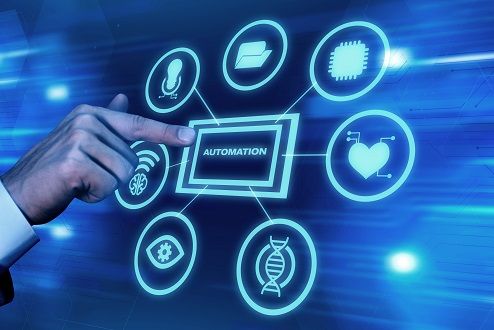Automation technology revolutionizing the Customer Acquisition solution
Automation technology is revolutionizing the way businesses acquire customers. Automation solutions are making it easier and faster than ever before to access customer data, process analytics, and deliver tailored experiences.

Automation technology is revolutionizing the way businesses acquire customers. Automation solutions are making it easier and faster than ever before to access customer data, process analytics, and deliver tailored experiences. Automation technologies can streamline the acquisition process from start to finish, from finding prospects to delivering personalized messages and offers. Automation solutions enable businesses to reach more customers in a shorter period of time, maximize their marketing budgets, and gain insight into customer behavior. With an Automated Customer Acquisition Offering/solution, businesses can leverage cutting-edge technology to revolutionize their customer acquisition efforts.
Benefits of automation technology in customer acquisition
Benefits include the ability to access relevant customer data quickly, analyze and segment prospects accurately, deliver customized campaigns based on customer behavior, track results in real time, and optimize campaigns for maximum success. Automation technology also helps businesses reduce costs by eliminating manual labor and automating mundane tasks such as prospecting, data entry, and follow-up emails.
Overall, automation technology has revolutionized the way businesses acquire customers. By leveraging cutting-edge solutions that are tailor-made for their unique needs, companies can increase sales productivity while minimizing operational costs. In addition to the cost savings, automated customer acquisition offerings/solutions provide a more personalized experience for customers which can lead to better relationships with them in the long run. Automation technology is setting a new standard for how businesses acquire customers, and those who are willing to invest in it will likely reap the rewards.

By using automation technology, businesses can reach more prospects, acquire higher quality leads, convert them into customers quickly and easily, and build relationships that last. Automation is transforming customer acquisition from a manual process to an efficient and effective one that delivers results. Companies should consider taking advantage of this revolutionary technology to maximize their success in customer acquisition.
Examples of automation technology used in customer acquisition
An example of automation technology used in customer acquisition is predictive analytics.
Predictive analytics uses data to predict customer behaviors and reveal insights that can be used to make better-informed decisions about how to target, engage, and retain customers.
AI-based chatbots are another way businesses can use automation technology to acquire customers.
Chatbots provide an efficient and personalized way for prospects to interact with a business, enabling them to get answers faster and more conveniently than through traditional channels.
Automated email campaigns powered by machine learning are yet another popular way automate the process of reaching out to potential customers and delivering tailored messages at scale.
Finally, voice recognition and natural language processing (NLP) technologies can help businesses create personalized experiences for customers. By leveraging NLP technology, businesses can quickly respond to customer queries in real time, as well as deliver personalized messages that are tailored to their individual needs. This helps improve customer satisfaction and increases the likelihood of conversions.
Challenges in implementing automation technology in customer acquisition
As with any new technology, implementing automation in customer acquisition comes with some challenges. The main challenge is ensuring that the technology functions properly and delivers desired results. Additionally, there may be privacy or compliance issues related to collecting customer data or using automated processes. Lets take a deeper look on the types of challenges faced by the companies in implementing Automation in Customer Acquisition.
Integration with existing systems
To ensure smooth functioning of automated processes, the systems being used must be integrated with existing systems and software. This can be complex and time-consuming.
Data privacy & compliance: Automation technology may require collecting customer data which could break laws or regulations in certain areas. Companies need to make sure that their processes are compliant with all applicable laws and regulations before implementing automation.
Cost of implementation: Automation technology can be expensive to implement and maintain, so companies should carefully consider the costs and benefits when making a decision.
Training & onboarding: Automation requires training staff in order to ensure that the technology is used correctly and efficiently. This can be costly and time-consuming.
Future of automation technology in customer acquisition
The future of automation technology in customer acquisition is bright. Automation has the potential to revolutionize how businesses engage and acquire customers, with improved efficiency and accuracy. Companies should consider leveraging automation to maximize their success in customer acquisition.
Advancements in AI and machine learning in Customer Acquisition
AI will enable businesses to create more personalized and targeted experiences for their customers. This can help build relationships with customers and make them feel valued, while also driving up conversion rates and improving customer retention.
The use of automation technology in customer acquisition is set to increase in the future, as companies continue to recognize its potential benefits. It has already transformed how
Increased use of virtual and augmented reality in Customer Acquisition
The use of virtual and augmented reality are also becoming more popular for customer acquisition in offerings in some categories. Companies can create virtual experiences that show products or services in a realistic and engaging way, which can help attract customers and convince them to make purchases.
Additionally, AR/VR technology can be used to create interactive experiences that can help customers better understand a product or service before making a purchase. Overall, the use of automation technology in customer acquisition is set to become more prevalent as companies recognize its potential benefits.
By leveraging AI, machine learning, virtual and augmented reality, businesses can create more personalized and targeted experiences for their customers that will help increase conversions and retention rates. Automation technologies can also help reduce costs
Personalization and customization
Personalization is key when it comes to customer acquisition. Companies should strive to create a unique and tailored experience for individual customer, as this will help them stand out from the competition and increase conversions. Automation can enable companies to customize experiences based on customer data and behavior, which can lead to higher conversion rates.
Overall, automation technology has the potential to revolutionize customer acquisition strategies. With the help of AI, machine learning, virtual and augmented reality, companies can create more personalized experiences that will help increase conversions and retention rates. Automation technologies also have the potential to reduce costs associated with customer acquisition.
Conclusion
Automation technology has the potential to revolutionize customer acquisition strategies. With advances in AI, machine learning and virtual/augmented reality, businesses can create more personalized and targeted experiences that will help increase conversions and retention rates. Automation technologies also have the potential to reduce costs associated with customer acquisition. Companies should consider leveraging automation to maximize their success in customer acquisition.
